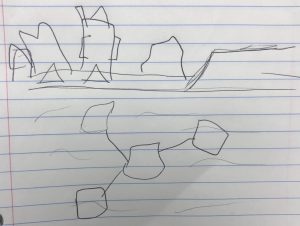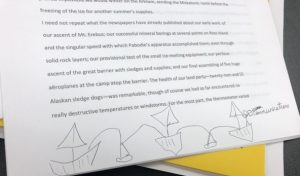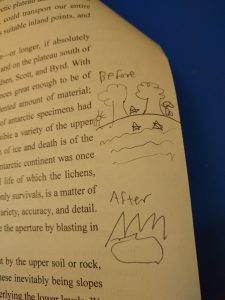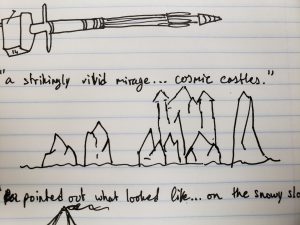In the Mountains of Madness, I feel like there is abjection. When members of the group are killed/go missing, William and his fellow crew member are more concerned over new discoveries rather than people dying. Maybe they were so shocked, they didn’t know how to react. There is also the sublime. When the pair discovered that the mountains were actually walls surrounding a city of some sort, that makes us wonder. Who could’ve made all this? The missing creatures that they found earlier? Who knows. As far as the uncovering of secret revelations destabilize identity, I’m not too sure, as I’ll have to look more into the story. I feel like there definitely are gender norms in Mountains of Madness. All of the crew members seem to be men and not a single women. This makes me wonder if Lovecraft thinks of women as inferior and incapable of thinking or enduring weather conditions. The ruins/city are symbolic as they represent the past, a civilization that once flourished, and human curiosity to expand the understanding of their world. The passage gives a clue to Lovecraft’s outlook on science by showing that everything may not be what they seem, such as the mountains actually being walls of a city. This also hints that Lovecraft believes there is a lot of mysteries out there that we may not know. Not only that, but could abnormal creatures like the ones in this story exist? After all, we haven’t even explored the all the oceans entirely. Maybe we’ll find something as bizarre as what Lovecraft describes or even more.
Category: Lovecraft, “At the Mountains of Madness, III-V
Posts on “At The Mountains of Madness,” III-V.
Jeremy Eisner Group 1 Connect
The narrator of “At the mountains of madness” describes the large city that the explorers find at over the foothills with an awe inspired voice of amazement and fascination. He describes the city by saying “ for above all my bewilderment and sense of menace there burned a dominant curiosity to fathom more of this age-old secret—to know what sort of beings had built and lived in this incalculably gigantic place, and what relation to the general world of its time or of other times so unique a concentration of life could have had” . The narrator experiences a sense of awe from being in a seemingly endlessly large space and wonders just how life was like long ago when these creatures used to live there. The narrator has just experienced the sublime in the way he talks about the city that is very similar to how we look at the cathedral found in the Castle of Otranto. When we think about the churches founded in the Gothic times, we try to imagine being inside the church. The size of us compared to the size of the church creates a dynamic that creates an awe inspiring feeling of being in such a gigantic space. The narrator looks back at a time in history when some sort of beings lived in such a vastly humongous civilization in the same we as we look back to Gothic times to understand how Manfred and all the other characters were living in such a large space as well.
Announcements for Tuesday, October 22
Hi class,
Good to see you today – I look forward to reading your papers.
Some notes:
-Please finish Part II as well as Parts III-V of “At The Mountains of Madness” for Thursday’s class. These are shorter parts, and if you wish, you can listen along to the audiobook here (scroll down to the video info to click on a specific section). Please print and bring to class!
No formal annotations this time, to leave room to think about Gothic Spaces presentations (see below).
-Blog group 1 (Sierra, Brian, Kerri, Jeremy, Janiya), please review the critical response prompts, and select 1 to respond to. As usual, try to ensure that you cover all the prompts amongst yourselves. Post by beginning of class on Monday.
-Below are your Gothic Spaces Presentation groups, followed by suggestions for virtual, cinematic, or real spaces your group could focus on. You will have some time to discuss with your groups on Thursday, but you should spend some time (~15-20 mins) investigating some of these titles and deciding which might appeal. Alternatively, if you have another idea, you should come prepared to discuss your preferred choice.
Video Game group: Kerri, Brian, Jeremy, Freddie
Suggested video games: Silent Hill, Resident Evil, Anchorhead, Amnesia, Call of Cthulhu: Dark Corners Of The Earth
Critical Response Prompts: At The Mountains of Madness, III-V
Each of the prompts should be answered by at least 1 member of blog group 2. Please confer amongst yourselves as to who will write which prompt. (Each member should try to do a different category than the one(s) they’ve already done!) Responses should be at least 250 words and posted by 11 am the day of class. Please remember to select the appropriate Blog category before posting.
CLUE. Pick one detail related to any of the following:
-plot (a major event that amps up conflict, or revelation that provides key backstory)
-point of view (a moment where the narrator shows his limits, or moves between describing what he knew “then” and what he knows “now”)
-setting (descriptions of atmosphere or geography)
Write about how that detail might provide a clue as to the story’s perspective on any of the themes we’ve discussed in class: tampering with nature, American conquest of the unknown, and/or the inability of scientific language to adequately “explain” what the narrator encounters.
CONNECT. Pick a passage and connect it to any of the texts we’ve discussed in this class so far. It could be a point of contrast or a parallel. Make sure you expand on the comparison, beyond simply saying “it’s the same” or “it differs.”
CREATE. Draw a visual representation of any of the scenes in this section. It doesn’t have to be intensely detailed, but it should be a bit more involved than the visual annotations we did last class. Upload it as a JPG, and in 3-4 sentences, explain what the picture represents. Include direct quotes that refer to the text of the story.
Announcements: Finishing Your Paper; Lovecraft Visual Annotations
Hi class,
Best wishes as you finish your first graded paper this term. Some useful links:
–Handout on macrostructure and microstructure of a literary analysis essay
–Sample literary analysis article on M.R. James if you’re looking for concrete examples
-Your partner’s peer review comments
As mentioned in class, please print a copy and bring to class with your partner’s peer review comments stapled to the back. Please also upload a Word doc to this Dropbox file request.
Good luck! Below are some of your visual annotations for “At The Mountains Of Madness.” I hope the exercise gave you a different strategy for “breaking into” a text and engaging with its multiple meanings. Some of the detail here is really perceptive.
Katie:
Kerri:








